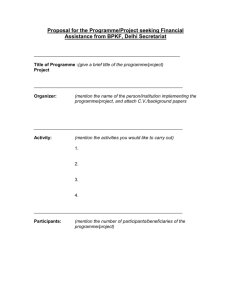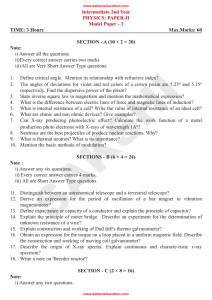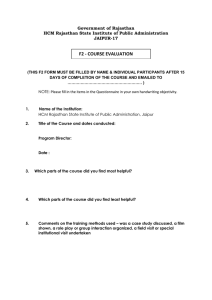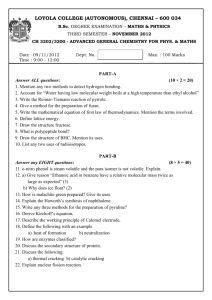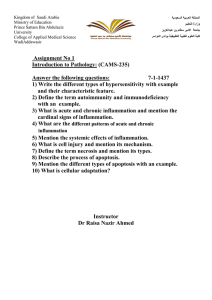Download the Book
advertisement
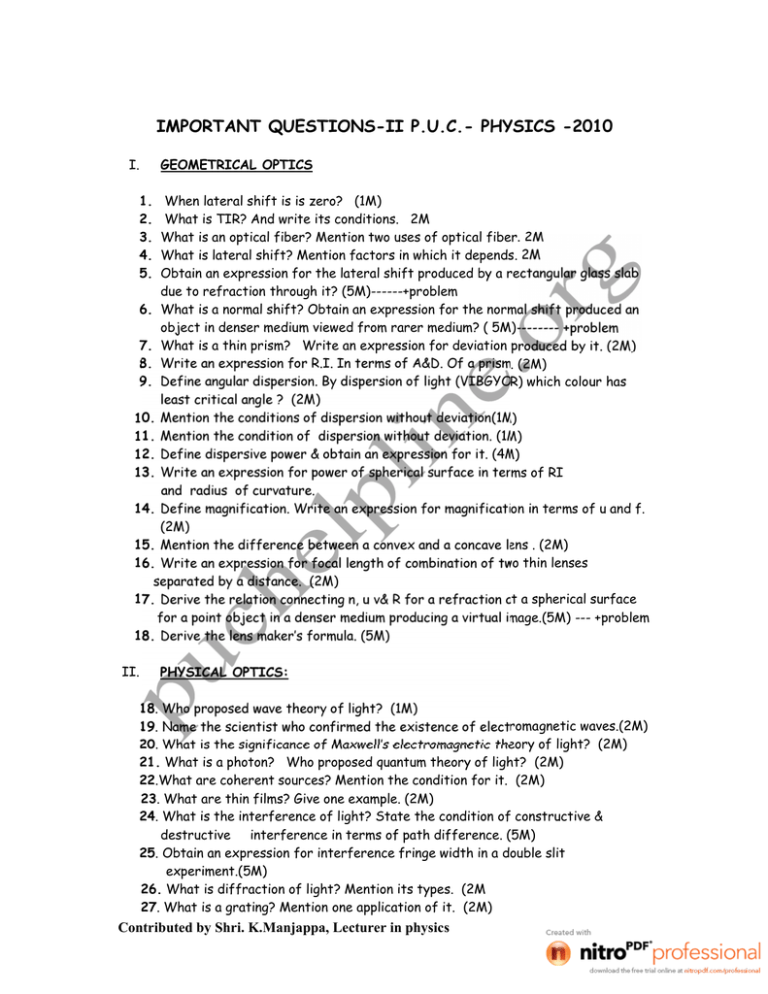
IMPORTANT QUESTIONS-II P.U.C.- PHYSICS -2010 I. GEOMETRICAL OPTICS 1. 2. 3. 4. 5. When lateral shift is is zero? (1M) What is TIR? And write its conditions. 2M What is an optical fiber? Mention two uses of optical fiber. 2M What is lateral shift? Mention factors in which it depends. 2M Obtain an expression for the lateral shift produced by a rectangular glass slab due to refraction through it? (5M)------+problem 6. What is a normal shift? Obtain an expression for the normal shift produced an object in denser medium viewed from rarer medium? ( 5M)-------- +problem 7. What is a thin prism? Write an expression for deviation produced by it. (2M) 8. Write an expression for R.I. In terms of A&D. Of a prism. (2M) 9. Define angular dispersion. By dispersion of light (VIBGYOR) which colour has least critical angle ? (2M) 10. Mention the conditions of dispersion without deviation(1M) 11. Mention the condition of dispersion without deviation. (1M) 12. Define dispersive power & obtain an expression for it. (4M) 13. Write an expression for power of spherical surface in terms of RI and radius of curvature. 14. Define magnification. Write an expression for magnification in terms of u and f. (2M) 15. Mention the difference between a convex and a concave lens . (2M) 16. Write an expression for focal length of combination of two thin lenses separated by a distance. (2M) 17. Derive the relation connecting n, u v& R for a refraction at a spherical surface for a point object in a denser medium producing a virtual image.(5M) --- +problem 18. Derive the lens maker’s formula. (5M) II. PHYSICAL OPTICS: 18. Who proposed wave theory of light? (1M) 19. Name the scientist who confirmed the existence of electromagnetic waves.(2M) 20. What is the significance of Maxwell’s electromagnetic theory of light? (2M) 21. What is a photon? Who proposed quantum theory of light? (2M) 22.What are coherent sources? Mention the condition for it. (2M) 23. What are thin films? Give one example. (2M) 24. What is the interference of light? State the condition of constructive & destructive interference in terms of path difference. (5M) 25. Obtain an expression for interference fringe width in a double slit experiment.(5M) 26. What is diffraction of light? Mention its types. (2M 27. What is a grating? Mention one application of it. (2M) Contributed by Shri. K.Manjappa, Lecturer in physics 1 28. Distinguish between Fresnel & Fraunhofer diffraction of light. (2M) 29. Distinguish between interference & diffraction of light. (2M) 30. State & explain Raleigh’s criteria of limit of resolution .(4M) 31. Write an expression for resolving power of microscope .(2M) 32. Write an expression for limit of resolution &resolving power of telescope . (4M)+problem 33. Define polarisation of light.show that plane of vibration and plane of polarization in a tourmaline crystal. (2M) 34. What is double refraction? Distinguish between O-ray & E-ray. (2M) 35. What is a Polaroid? Mention two uses of it. (2M) 36. Define optical activity and specific rotation of optically active solution. (2M) 37. Define circularly and elliptically polarized light. (2M) 38. Define Brewster”s law.Show that reflected & refracted rays are perpendicular to each other at the polarising angle of incident.(5M)------ +problems 39. Name the scientist who experimentally measured the speed of light first time. (1M) 40. Give the value of speed of light by Michelson’s rotating mirror experiment. (1M) 41. Mention two importance’s of speed of light . (2M) III ELECTROSTATICS: 1. Distinguish between electric intensity & potential. (2M) 2. State Coulomb's law in electrostatics (2M) 3. Write an expression for Coulomb’s law in vector form. (2M) 4. Define one coulomb. Give SI unit of permittivity of free space. (2M) 5. Distinguish between polar and non-polar dielectrics. (2M) 6. State dielectric polarization. (1M) 7. Define electric dipoles. Write an expression for the torque acting on an electric dipoles. (2M) 8. State Gauss theorem. Obtain an expression for electric field at any point near the surface of the charged conductor using Gauss theorem. (5M) 9. State Gauss theorem. Obtain an expression for electric field at any point near the spherical charged conductor using Gauss theorem. (5M) ------ + problem 10. Derive an expression for the electric potential at a point due to a point charge.(5M) + problem 11. What is capacitance of a capacitor.? (2M) 12. Write an expression for capacity of spherical conductor. (2M) 13.How does capacitance of parallel plate capacitor depends (2M) 14. Write an expression for energy stored in a capacitor (2M) 15. Write an expression for capacitance of cylindrical capacitor. (2M) Contributed by Shri. K.Manjappa, Lecturer in physics 2 16. Obtain an expression for effective capacitance of three capacitors in series or parallel.(5M) +problems IV. CURRENT ELECTRICITY: 17. State Ohms law. Mention its limitations. 2M 18. Define drift velocity. And internal resistance of cell. (2M) 19. What is a super conductor? Give an example. (2M) 20. What is a thermistor? How does resistance of a thermistor vary temp. ?2M 21. Mention two applications of a thermistor?.2M 22. Derive the expression for branch currents when two resistors are in parallel. 2M +problems 23. .Obtain an expression for the effective resistance of three resistors in parallel . 5M +problems 24. Obtain an expression for the current in a resistance connected across a battery 2M 25. State the Kirchhoff’s' laws . and mention its significance. 2M 26. Draw the circuit diagram of Wheatstone's network. Mention its balanced condition.2M 27. Obtain the condition for balance of a Wheatstone network by applying Kirchhoff’s' laws 5M +problems 28. State reduction factor of tangent galvanometer.2M 29. State & explain Laplace law.5M +problems 30. Give the initial adjustment of TG. (5M) 31. What are magnetic elements of earth? And give tangent law. (2M) 32. Give the theory of TG. 5M +problems 33. Obtain an expression for the magnetic field at any point on the axis of a circular coil carrying current.5M +problems 34. Write an expression for the force between two conductors carrying currents. 2M 35. Give the condition of attractive and repulsive force between two parallel conductor carries current. (2M) 36. State Fleming’s left hand rule 2M 37. Give the expression for torque acting on a current loop kept in a magnetic field. 2M 38. Give the theory of moving coil galvanometer. 5M +problems 39. How is galvanometer converted in to an ammeter & a voltmeter? 5M +problems 40. State & explain Faraday's laws of electromagnetic induction. 5M 41. State self induction of a coil . Mension its SI unit. 2M 42. State Fleming’s right hand rule 2M 43. Write an expression for energy stored in a coil. 2M 44. What is average e.m.f of an a.c ? Write the relation between r.m.s and peak value of an a.c Contributed by Shri. K.Manjappa, Lecturer in physics 3 45. What is meant by impedance of A.C circuit 2M +problems 46. Derive an expression for the alternating e,m,f. When a coil is rotating in a uniform magnetic field. 5M 48. Show that the voltage leads the current by π/2 in A.C circuit containing pure inductance. 5M +problems 49. What is resonance in an A C circuit? 2M 50. Derive an expression for current in an AC circuit containing series LCR elements. 5M +problems 51. Explain the terms self induction & mutual induction (2M) 52. Draw a diagram of ac meter and explain power loss in a transformer. (2M) V MODEREN PHYSICS 1 . Name two types of electron emission. 2. What are Fraunhoffer lines? (2M) 3. Define specific charge of electron and write its value. (2M) 4. Distinguish between line spectra and band spectra. (2M) 5 . Define the term threshold wavelength & stopping potential. (2M) 6. Derive an expression for Einstein's photoelectric equation (5M) +problems 7. Define photoelectric effect .explain experimental observed facts of photoelectric effect (5M) 8. Mention two uses of photocell. 2M 9. State & explain postulates of Bohr's theory of Hydrogen atom. 5M 10. Derive an expression for the energy of electron in the nth Bohr orbit of the hydrogen atom. 5M +problems 11. Obtain an expression for the velocity & radius of the electron in the nth Bohr orbit of the hydrogen atom. 5M +problems 12. Derive an expression for the frequency of electron in the Bohr hydrogen atomic model. 5M +problems 13. What are the characteristics of nuclear force.2M 14. Explain the characteristics of a nucleus with reference to its size, charge, density & mass 5M 15. Give Einstein's mass energy relation 2M 16. Explain the term mass defect & binding energy curve. 5M +problems 17. Distinguish between nuclear fission & nuclear fussion. 5M 18. What is NMR? Give one application of it. (2M) 19 Give the charge of α,β & γ rays. (2M) 20. What is radioactivity? Name the types of radioactive radiations. 2M 21. Define half life period & mean life? 2M +problems 22. State Soddys group displacement laws 5M 23. State & explain laws of radioactive decay. Deduce an expression for the no. of atoms of radioactive element at any instant of time . 5M +problems 24.What are matter waves? Write an expression for de Broglie wavelength. (2M) Contributed by Shri. K.Manjappa, Lecturer in physics 4 25.What is working principle of electron microscope? (2M) 26.What is scattering of light? Name the types scattering of light. (2M) 27.What is Raman effect? Mention its two uses. (2M) 28.What are stocks and anti-stocks lines ? (2M) 29. What is LASER? Give the two properties and uses of laser. (2M) 30.Draw a neat labeled diagram of ruby laser. (2M) 31.Name the types of elementary particle give an example. (2M) 32.What is a lepton? Give an example. (2M) 33.What is AND and OR gate ? give its symbol. (2M) 34.Write truth table and Boolean equation of NOT gate. (2M) 35.Name two types of liquid crystals. Give the two properties and uses of liquid crystals. (2M) 36.What is an emulsion? Give an example. (2M) 37.What is gel and foams ? Give an example. (2M) 38. Classify conductor, semi conductor & insulator on the basis of band theory of solid 5M 39. Distinguish between intrinsic & extrinsic semiconductors.2M 40. Distinguish between p- type & n-type semiconductors. 2M 41. What is rectification? Explain with a circuit diagram the working of diode as full wave rectifier. 5M 42.What is rectifier? Explain with a circuit diagram the working of diode as half wave rectifier / full wave rectifier 5M 43.What is a transistor? Explain the action of a npn transistor as an amplifier .5M 44.What is a photo diode? Write the symbolic representation of it. (2M) 45.What is forward and reverse bias of a diode. (2M) Contributed by Shri. K.Manjappa, Lecturer in physics 5 II PUC PHYSICS PRACTICAL EXPERIMENTS – 2010 1.To determine the focal length of convex lens by shift method & radii of curvature by Boy's method & refractive index of convex lens at least 4 trials 2.To Verify Ohm’s law and the law of combination of resistors in parallel method[at least 4 trials] 3. Determine the resistivity of the material of the given wire using meter bridge (At least 4 trials for finding resistance).Length of the wire = 1.5 mtr 4.Determine the temperature coefficient of resistance of the thermistor using a meter bridge.[ at least 4 trials] 5.Determine the current sensitivity of the given pointer galvanometer .Take at least three sets readings. 6. Determine the self-inductance of the given coil by direct method. Take at least three sets of readings. Frequency of AC = 50 Hz 7. Determine “ BH “ at the given place using tangent galvanometer. Take at least three sets of readings. Circumference of the TG coil = 50 Cm. 08. Determine the specific heat of the given liquid by electrical method. specific heat of the material of the calorimeter c=385J/kg-k. 9.Draw the characteristics of the given semi-conductor diode and calculate its forward resistance & Knee voltage. 10.To convert galvanometer into a voltmeter of given range .sensitivity of the galvanometer=1.5x 10 –5A/div The Resistance of galvanometer = 95Ω Voltmeter range = 2 Volts 11.To determine the internal resistance of a cell using potentiometer at least 4 trials. 12 To determine dispersive power of material of a prism for blue &green colour using spectometer. Angle of prism a =60degree Contributed by Shri. K.Manjappa, Lecturer in physics 6
